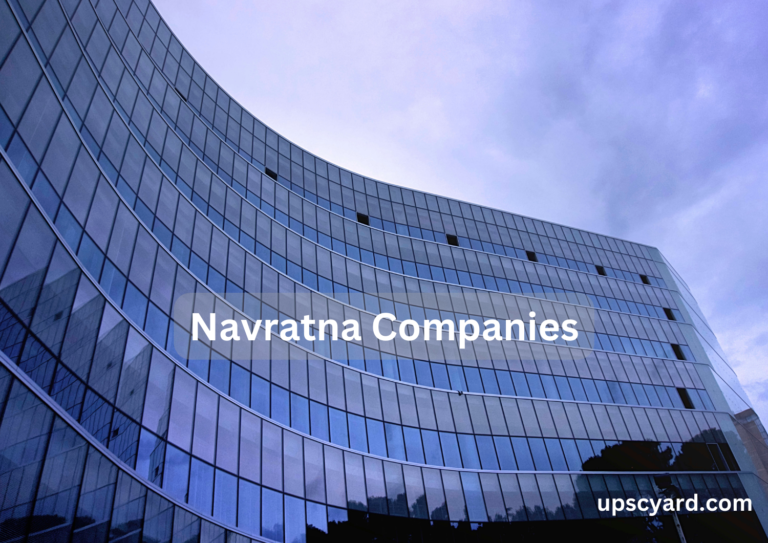04 AUG 2021
The authorities have given the green light for the establishment of 11 Industrial Corridors, encompassing 32 distinct projects. These initiatives are set to unfold across four distinct phases as a crucial component of the National Industrial Corridor Programme (NICP).
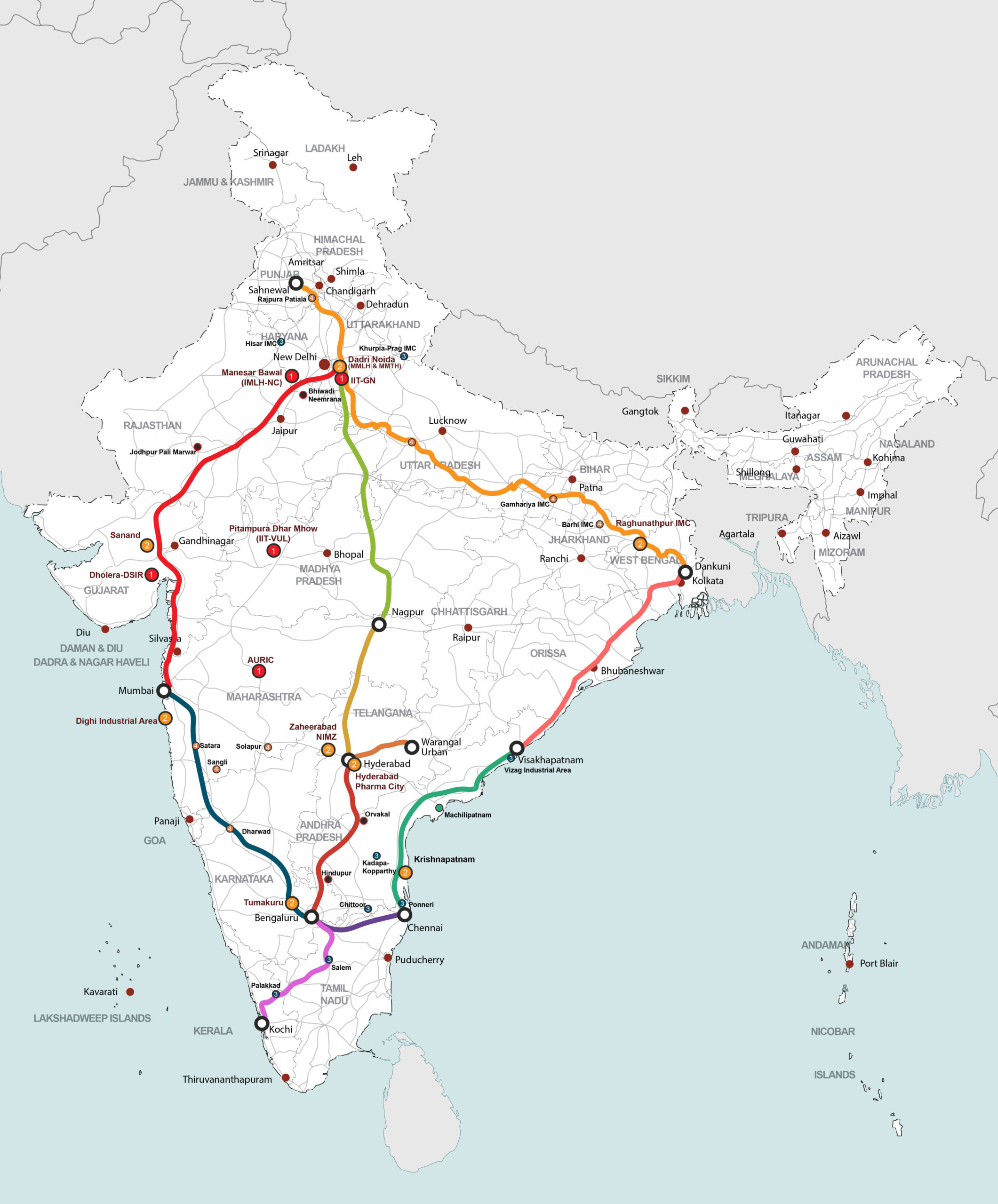
Summary of industrial corridor
The various sectors within an economy rely on each other in a web of interconnectedness. Recognizing this intricate relationship, industrial corridors emerge as bridges linking industry and infrastructure, ultimately fostering comprehensive economic and societal progress. These corridors constitute top-tier facilities, encompassing:
- Swift and efficient transportation networks via railways and roads.
- Cutting-edge ports equipped with advanced cargo handling systems.
- Modernized airports tailored to meet contemporary needs.
- Special economic zones and industrial precincts.
- Logistic parks and hubs for seamless trans-shipment.
- Knowledge hubs designed to serve industrial requirements.
- Accompanying infrastructure like townships and real estate.
- Urban infrastructure complemented by supportive policy frameworks.
The Government of India has sanctioned the development of 11 industrial corridors, spanning 32 projects and divided into four phases. The current roster of industrial corridors is as follows:
- Delhi Mumbai Industrial Corridor (DMIC)
- Chennai Bengaluru Industrial Corridor (CBIC)
- Expansion of CBIC to Kochi via Coimbatore
- Amritsar Kolkata Industrial Corridor (AKIC)
- Hyderabad Nagpur Industrial Corridor (HNIC)
- Hyderabad Warangal Industrial Corridor (HWIC)
- Hyderabad Bengaluru Industrial Corridor (HBIC)
- Bengaluru Mumbai Industrial Corridor (BMIC)
- East Coast Economic Corridor (ECEC) featuring Phase-1 Vizag Chennai Industrial Corridor (VCIC)
- Odisha Economic Corridor (OEC)
- Delhi Nagpur Industrial Corridor (DNIC)
The National Industrial Corridor initiatives are meticulously crafted within the broader framework of PM GatiShakti – the National Master Plan. This blueprint aims to establish systematic, multi-modal connectivity across economic zones, promoting the seamless movement of goods, services, and people, ultimately fostering efficient logistical and economic activities.
Overseen by the National Industrial Corridor Development and Implementation Trust (NICDIT), the development of these eleven industrial corridor projects extends across India, concentrating on inclusive growth to stimulate industrialization and planned urban development. Smart cities are also sprouting along these corridors. Endowed with advanced infrastructure, these cities will house the emerging workforce essential for propelling manufacturing, and in turn, fostering orderly urbanization.
This strategic maneuvar positions India as a formidable contender in the Global Value Chain, amplifying the nation’s competitiveness in manufacturing through the creation of top-notch infrastructure.
To fund these endeavors, a substantial allocation of USD 1.22 billion (INR 8715.07 crores) was released, with USD 1.02 billion (INR 7315.07 crores) already utilized by March 2021.
Notably, ‘Plug n Play’ infrastructure has been established at the plot level in four cities: Dholera (Gujarat), Shendra Bidkin (Maharashtra), Vikram Udyogpuri (Madhya Pradesh), and Integrated Industrial Township (Greater Noida, Uttar Pradesh), with land allotments currently underway.
Across these four cities, a total of 173 plots spanning 851 acres have been assigned, attracting investments from countries like South Korea, Russia, China, the UK, Japan, and India, including contributions from MSMEs. This concerted effort has mobilized investments approximating INR 16,760 crore, generating around 21,000 employment opportunities.
These projects are presently in different phases of planning, development, and execution. Here’s a snapshot of their current statuses:
| Sl. No. | Corridor | No. of Projects | Name | Status |
|---|---|---|---|---|
| 1 | DMIC: Delhi Mumbai Industrial Corridor | 10 | 1 Dholera Special Investment Region (DSIR), Gujarat 2 Shendra Bidkin Industrial Area (SBIA), Maharashtra 3 Integrated Industrial Township – Greater Noida (IIT-GN), Uttar Pradesh 4 Integrated Industrial Township – Vikram Udyogpuri (IIT-VUL), Madhya Pradesh 5 Integrated Multi-Modal Logistics Hub – Nangal Chaudhary, Haryana | Under Implementation |
| 6 Multi Modal Logistics Hub & Multi Modal Transport Hub (MMLH & MMTH), Uttar Pradesh | Project has been approved on 30/12/2020 | |||
| 7 Dighi Port Industrial Area, Maharashtra 8 Multi Modal Logistics Park, Sanand, Gujarat 9 Jodhpur Pali Marwar Industrial Area, Rajasthan 10 Khushkhera Bhiwadi Neemrana Industrial Area, Rajasthan | Project development activities underway | |||
| 2 | CBIC: Chennai Bengaluru Industrial Corridor | 3 | 1 Krishnapatnam Industrial Area, Andhra Pradesh 2 Tumakuru Industrial Area, Karnataka | Projects have been approved on 30/12/2020 |
| 3 Ponneri Industrial Area, Tamil Nadu | Project development activities underway | |||
| 3 | Extension of CBIC to Kochi via Coimbatore | 2 | 1 Palakkad Industrial Area, Kerala 2 Dharmapuri, Tamil Nadu | – |
| 4 | AKIC: Amritsar Kolkata Industrial Corridor | 7 | 1 Raghunathpur Industrial Park, West Bengal 2 Hisar Integrated Manufacturing 3 Cluster IMC, Haryana 4 Prag Khurpia Integrated Manufacturing Cluster IMC, Uttarakhand 5 Rajpura Patiala IMC, Punjab Agra, Uttar Pradesh 6 IMC at Gaya, Bihar 7 IMC at Jharkhand | Project development activities have not initiated yet |
| 5 | HNIC: Hyderabad Nagpur Industrial Corridor | 1 | 1 Zaheerabad Phase 1, Telangana | Project development activities underway |
| 6 | HWIC: Hyderabad Warangal Industrial Corridor | 1 | 1 Hyderabad, Phase 1, Telangana | – |
| 7 | HBIC: Hyderabad Bengaluru Industrial Corridor | 1 | 1 Orvakal Industrial Area, Andhra Pradesh | – |
| 8 | BMIC: Bengaluru Mumbai Industrial Corridor | 2 | 1 Dharwad Node, Karnataka 2 Satara Node, Maharashtra | – |
| 9 | VCIC: Vizag Chennai Industrial Corridor | 3 | 1 Koparthy Industrial Area, Andhra Pradesh 2 Vishakhapatnam Industrial Area, Andhra Pradesh 3 Chitoor Industrial Area, Andhra Pradesh | Project development activities underway |
| 10 | OEC: Odisha Economic Corridor | 1 | a. Paradip-Kendrapada-Dhamra-Subarnarekha, Odisha b. Gopalpur-Bhubaneshwar-Kalinganagar, Odisha | – |
| 11 | DNIC: Delhi Nagpur Industrial Corridor | 1 | Under conceptualization | – |
Dholera Special Investment Region (DSIR), Gujarat
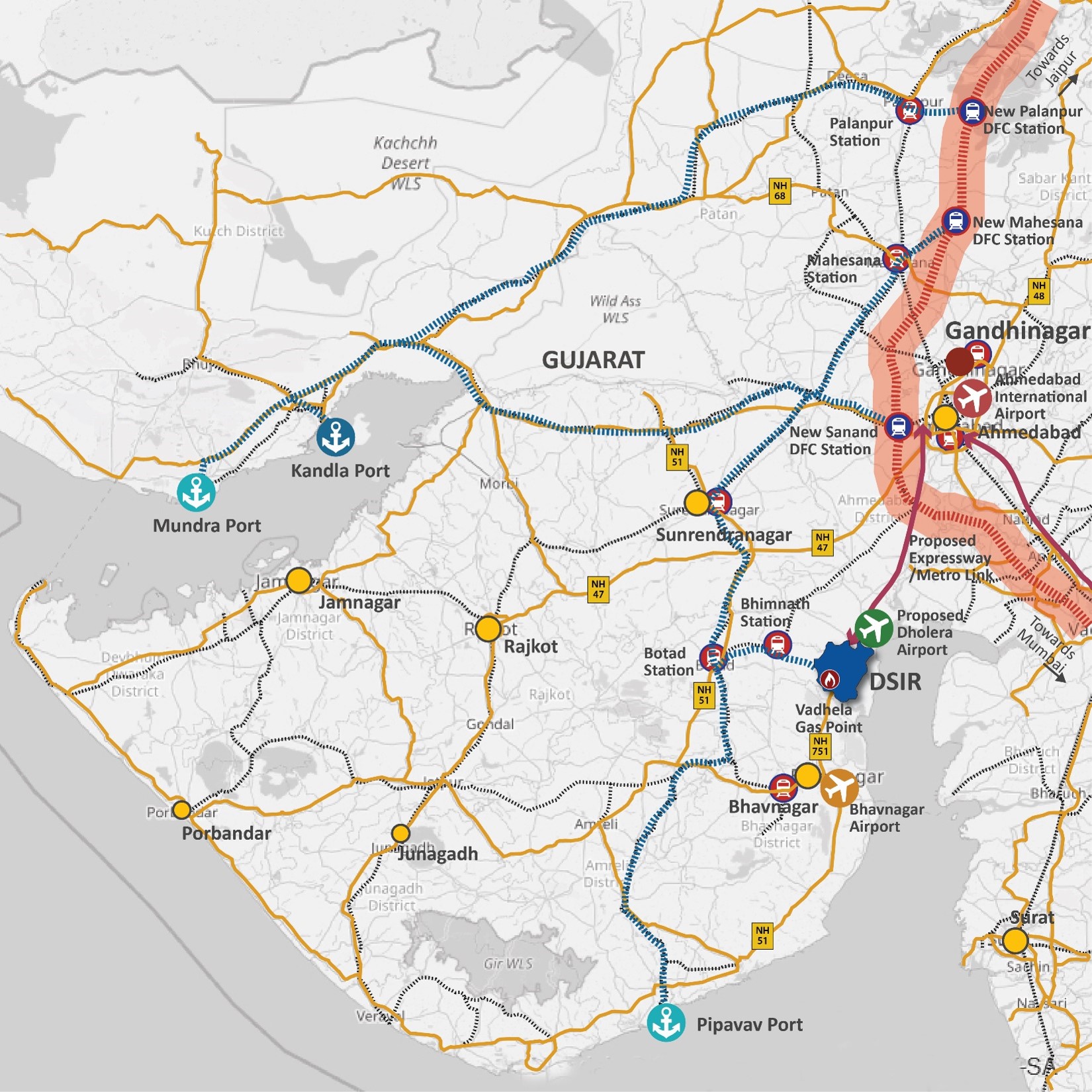
Integrated Industrial Township – Vikram Udyogpuri (IIT-VUL), Madhya Pradesh
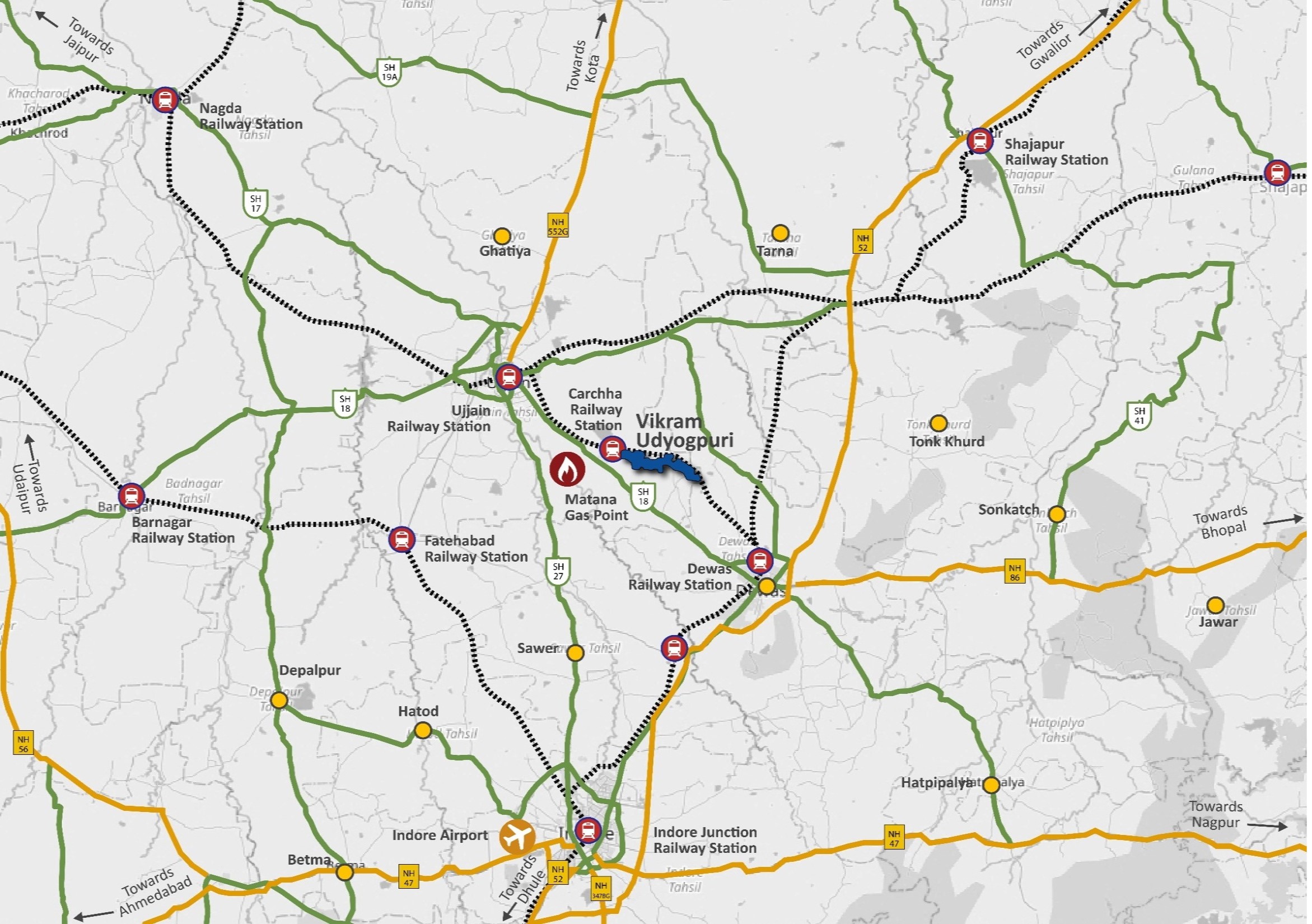
Integrated Industrial Township – Greater Noida (IIT-GN), Uttar Pradesh
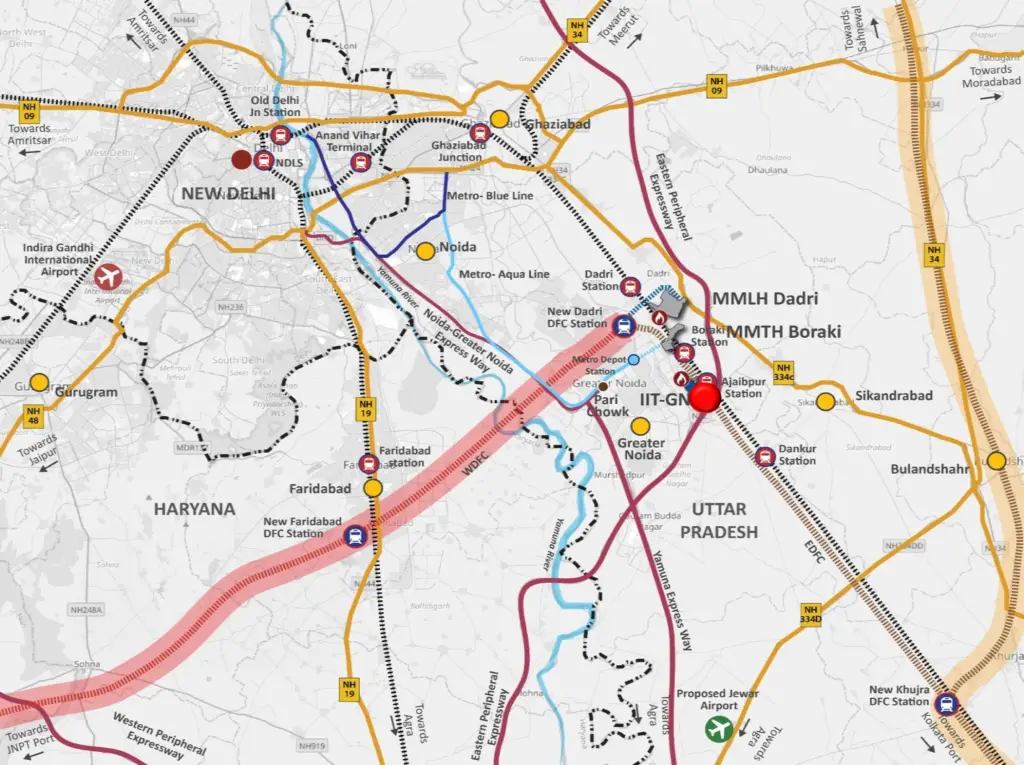
Economic significance
Gateway to Employment: The emergence of Industrial Corridors acts as a magnet for investments, fostering the growth of industries and thereby creating a surplus of employment prospects. Importantly, individuals can find job options in proximity to their residences, eliminating the need for long-distance migration and averting distress-driven movements.
Trade Routes Unveiled: The Industrial Corridors have the potential to drive down logistical expenses, subsequently enhancing the efficiency of the industrial production framework. This streamlined efficiency results in reduced production costs, bolstering the competitiveness of Indian-manufactured goods in the global arena. As surplus goods are readied for export, a surge in job opportunities becomes a reality, ultimately elevating per capita incomes.
The industrial corridor concept extends opportunities for private sector involvement in supplying diverse infrastructure projects linked to harnessing industrial potential.
These corridors lay the foundation for vital logistical infrastructure, essential for reaping the benefits of economies of scale. This, in turn, empowers businesses to focus on their core competencies.
Beyond the immediate infrastructure development, the long-term advantages for businesses and industries situated along these corridors encompass easy access to production units, diminished transportation and communication expenses, enhanced delivery timelines, and reductions in inventory costs.
Positive Social and Economic Impact: The ripple effects of industrial corridors in terms of society and economics are multifaceted. They encompass the establishment of industrial townships, educational centers, and medical facilities, collectively enhancing the benchmarks for human development.
Challenges Linked with Industrial Corridors
Acquiring Land: Obtaining the necessary land for these expansive industrial corridors has proven to be a gradual process. Legal obstacles and disputes over compensation have contributed to the delay in land acquisition.
Technological Expertise: India’s expertise in certain sectors is still evolving. To bridge this gap, increasing Foreign Direct Investment (FDI) limits could allow foreign players to bring their technological prowess. Encouraging Indian investment in supporting industries within these sectors would be beneficial.
Clarity in Taxation: The tax liabilities of foreign companies operating in India need clear definition, both as permanent establishments and under other circumstances.
Maintaining Macroeconomic Stability: A stable exchange rate is crucial to shield foreign investors from currency fluctuations, ensuring a secure environment for their investments.
Setting Clear Rules: India should establish transparent guidelines for license cancellations in Bilateral Investment Treaties, preventing potential confusion down the line, as seen in instances like the Antrix-Devas deal.
Ensuring Feasibility: Attracting potential investors to establish manufacturing units within National Manufacturing and Investment Zones (NMIZ) is essential to verify the economic and financial viability of these industrial corridors.
Addressing Displacement: As these corridors entail significant investments, there’s concern about potential mass displacement of people and the conversion of fertile agricultural land.
Tackling the Rural-Urban Gap: There’s a worry that these developments might inadvertently exacerbate the gap between rural and urban areas, affecting human development, economic well-being, and overall living standards.




